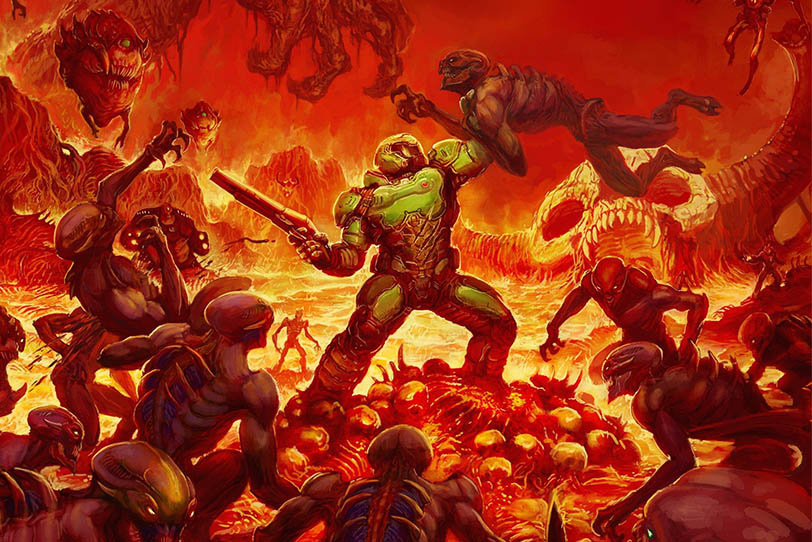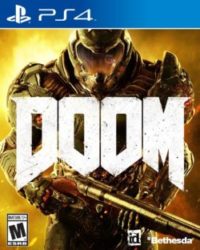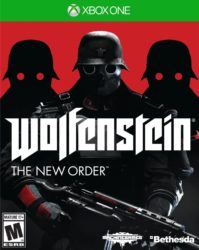There are few games that were as important to the development of first-person shooters than 1993’s Doom. Developed by id Software, Doom was one of the first games of its time to make use of 3D graphics and networked multiplayer gameplay. Though id Software went on to produce two sequels, Doom II: Hell on Earth (1994) and Doom 3 (2004), the series seemed to have fallen by the wayside in recent years. Doom 4, which was announced almost a decade ago in 2008, underwent a tremendously long development cycle, and was even scrapped and restarted in 2011. Since that time, many have been anticipating the release of Doom 4 (later renamed as just Doom in 2014), while also questioning if id could deliver a game that could live up to its critically acclaimed predecessors.
Rest assured, much like Bethesda Softworks and MachineGames’ Wolfenstien: The New Order (another of id’s beloved properties that have been treated especially well in recent years), id Software has created a much bigger and engrossing version of Doom that will satisfy both old-school fans and modern audiences alike.
Doom’s story is simple in its presentation and begins with the player character, the Doom Marine/Slayer, emerging from a creepy demonic sarcophagus. Forced to battle the demons and abominations arriving through a portal to Hell (stupidly opened by an evil corporation seeking to exploit Hell’s resources), the Doom Marine must close the portal in hopes of stopping Hell’s continued invasion. Along with the story, which is wonderfully goofy an irreverent, the campaign is chock-full of references to the first game and its sequels, and players will occasionally come across secret areas and levels designed and rendered to look like the original games.
Unlike so many contemporary first-person shooters that toss in a short, half-baked single player mode, Doom’s campaign is its best feature, and harkens back to the essence of what made the original Doom and other first-person shooters of its day so revered by fans and developers alike. Immediately thrust into combat with a heavy metal soundtrack blaring, the game spends little time acclimating players to the hellish chaos that has erupted on the remote Mars research facility. Combat is fast and requires players to constantly move as quickly as possible or risk being torn apart by Hell’s minions. Overtime, the game’s enemies will become more diverse and increasingly harder to defeat, but the gunplay remains consistently satisfying throughout the 16-hour campaign.
Additionally, Doom’s levels, while simplistic in design, are suitably atmospheric and emphasize the verticality of the combat. Even when tasked to backtrack through the red-sand covered landscapes of Mars or the cramped, twisting corridors of the demon infested facilities, the levels never become tedious or boring.
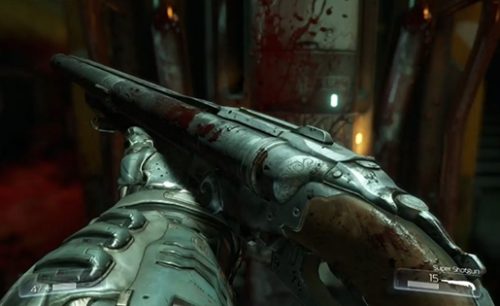
Doom also offers plenty of weapons to choose from, including such fan-favorites as the Super Shotgun (Double Barreled Shotgun) and the BFG 9000. As players progress through the campaign, weapons will grow even more powerful and elaborate in their demon killing abilities as upgrade points are collected. A new addition to the series, upgrade points can be spent on alternate weapon firing modes. In the heat of battle, players can switch from normal shotgun buckshot to a deadly explosive round. Other alternate firing modes for various weapons include charged shots, homing missiles and freeze blasts.
Aside from weapon upgrades, armor tokens can also be collected from the corpses of elite soldiers. Used to boost the stats of the Praetor combat armor, players can choose to upgrade their health, armor and ammo capacity. Secret optional challenge rooms found across the game’s levels can also reward players with upgrade abilities, such as faster glory kills and immunity to specific types of weapon damage.
Of all the new and best updates to Doom is the inclusion of the “glory kill system.” Glory kills may seem at first glance an unnecessary gimmick that breaks the flow of the game’s excellent first-person shooting, but they actually add to the combat experience, providing wonderfully gory and fast paced enemy kill animations. Glory kills also serve a practical purpose in combat. As in previous entries in the series, Doom has finite armor, health and ammo pickups scattered across its levels. However, glory kills on enemies will often produce ammo and health drops, providing players with additional incentive to make use of the combat system when engaging the monstrous legions of Hell.

Despite being infamously derided by players during its beta, Doom’s multiplayer, while offering little in terms of diversity from other multiplayer shooters, is definitely worth playing for those who want to test their skills upon completing the game’s lengthy single-player campaign. There are currently six multiplayer modes available to players, including Deathmatch, Domination, Clan Arena, Soul Harvest, Freeze Tag and Warpath. Of the modes that are available, Soul Harvest is the best, and tasks players with collecting the souls of their fallen foes in order to win.
Apart from Soul Harvest, the best reason to play multiplayer is for the ability to play as a demon. By picking up a demon rune, players can transform into one of several demon enemies seen in the campaign. Playing as a demon is endlessly fun, and if players take advantage of the powerful demonic powers at their disposable, they can often turn the tide of a match in their team’s favor in only a minute, if not a few seconds.
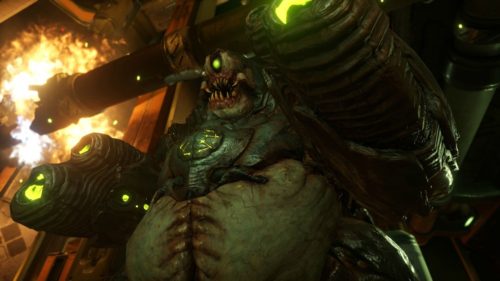
Another component of multiplayer is SnapMap, a level editor mode that lets players create and share custom single-player and multiplayer maps online. SnapMap, though surprisingly simple in its presentation, is rather robust in what it offers players in terms of customization, and it is already producing a ton of new user-created solo, co-op and multiplayer content. As the name suggests, SnapMap allows players to easily “snap” rooms, hallways, ceilings, walls and various other sections together through a map interface. Once the basic layout of a custom level has been created, further customization options are available. Players can then place various environmental hazards, including explosive barrels and flame spewing death traps, and most importantly, enemy spawns in locations of their choosing.
There are so few shooters on the market today that manage to offer such a rewarding and content-rich experience than Doom. Yes, it certainly helps that the game is buoyed by two decades of demon killing nostalgia, but it succeeds as much as it does because of the overwhelmingly amount of effort that seems to placed on things that so many first-person shooter developers tend to ignore or complete half-heartedly. With an abundant amount of style, humor and one of the best single-player campaigns that one can hope to play in an FPS, Doom proudly stands head and shoulders above many of its contemporaries.
Arbitrary Rating: 9 out of 10 eviscerated Cyberdemons
DOOM is currently available for purchase on PS4, PC and Xbox One.
What about you reader? What did you think of DOOM? Do you want more of these types of first-person shooters? Let us know in the comments below!
Interested in picking up some of the titles mentioned in the article? Please use our Amazon links to do so!

